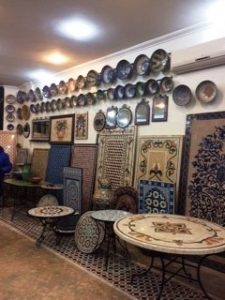
Submitted by Alexandra Eggleston on the 2017 winter session program in Morocco sponsored by the Department of Languages, Literatures and Cultures…
This week my pictures encompass the architecture of Morocco. With the passing of 3 weeks in this country, I must say this is my favorite aspect of the country. All of the ceramic and art captures the Moroccan culture. My first picture is one that was taken in Fez at a ceramics store that our group visited. We were given the opportunity to watch how various household items are made, for example there were plates, bowls, fountains, mugs,tables and much more.
My second picture was taken in Marrakech at a palace. This exemplifies Moroccan architecture. This picture is a small sample of the palace that was filled with a variety of different colors and forms of art. There were colorful tiles all around, on the floors, ceilings and even the fountains outside displayed phenomenal art.
Art to Moroccans is extremely important. Their culture embodies its religious beliefs through this art work by utilizing calligraphy. Calligraphy is a form of art in itself and is the dominant form in Morocco along with the architecture. The two forms are almost always intertwined into beautiful buildings and structures across all towns.
Lastly, I have added a picture of the group on our camel ride into the Sahara Desert! We spent a night at a camp mingling with the locals and learning about their lives, language and cultures. The next morning, we took 4-wheelers through the Sahara to find nomads and hear their stories. This for me, was the most touching experience. We came upon a mother that divorced her husband because he was a thief. Since she had no money and no where to go, she became a nomad and makes her living off of tourists coming by and buying blankets. Her goal is to use this money to send her son to school since she was never given the opportunity to go to school herself. Many of us in the group bought carpets and items from her to aid her in achieving this goal.
This experience was saddening to think that there are 40,000 others in Morocco just like this poor woman. On the other hand, it is empowering to think that as I receive my education I may one day be able to turn around and use my studies to help those in need not only in the U.S. but abroad as well.


